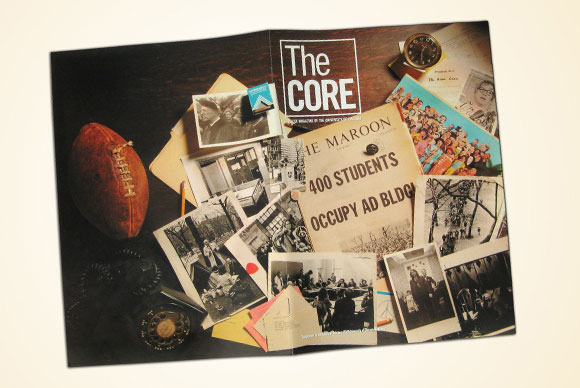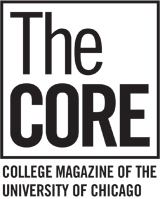
Letters
Boring articles, lazy
writers, football should be
banned—again!
FROM ALL SIDES
I read “Which Side Are You On?” (Jan–Feb/10) with considerable interest, and appreciation for the professionalism of the reportage—up to the end. Now, I came late to an appreciation of athletics (at Chicago I was among those then-dean Alan Simpson called “mealy-mouthed, mushy-minded intellectual monks” for our opposition to the Stagg scholarships), and I have no quarrel with Chicago again fielding a football team, but the conclusion of the story, that “the biggest change to undergraduate life” as a result of the sit-in and its aftermath was the return of varsity football in 1969, is pretty lame and, if true, really disappointing. Students have gained no voice in governance?
—Georgia M. Green, AB'66, AM'69, PhD'71
“Which Side Are You On?” begins by calling the 1969 redesign of the Maroon, which moved news off the cover, “an odd decision since 1968–69 had already been turbulent.” I've been hearing the same pushback from my redesigns for 40 years.
The fact is, compared to 1968, there was no news on campus. I mean, after the police riot at the Democratic convention, can you call student housing complaints “news”? The biggest thing that fall was the inauguration of Edward H. Levi, PhB'32, JD'35, which if you look back, effectively squashed the antiwar movement.
[Levi's inauguration] dinner was covered brilliantly in the Grey City Journal by Michael Sorkin, AB'69, in a Norman Mailer-inspired piece, “On the Steps of the Hilton.” I doubt anyone at Chicago remembers that the Grey City Journal was started that year by Sorkin, the now-famous architect and writer, as a section of the Maroon, replacing “Culture Vulture.”
The fact is, the decision not to grant Marlene Dixon tenure was not news. Popular teachers fail to be made into professors all the time—then and now. What was news was the reaction from the left.
My feeling then, which I put into editorials, was indeed the campus was not generally interested in the cause, as the Maroon poll showed, but the SDS crowd had been itching to do something since the disastrous sit-in at Columbia the year before. Emotions took over. Levi countered the disturbance brilliantly at first. He manipulated the Maroon, like Henry Kissinger seducing the New York Times, and I wrote about that, too. No police were called.
After a month with no negotiations, the demonstrators quietly walked out. Only when the administration and the faculty senate started expelling students that spring did a majority of students begin to support the radicals. The Maroon, which had taken the uncomfortable middle ground (“You're all idiots”), tore into the administration and began calling for “student power,” a concept that baffled the professors.
Meanwhile, that redesign was my first, and while the typography looks a bit coarse now, I am proud of it. We took the “Chicago” out of the logo, to make it bigger. When hard news did happen, we adapted the front page. The pictures we ran on the new cover had just as much content as the written stories. (Typically the Core doesn't credit photographers, but many were from the Maroon). Editors, evidently, still have a hard time understanding visual content, which is one reason I decided there might be more room on the visual side of the media than on the verbal.
—Roger Black, X'70
Mr. Black was editor-in-chief of the Maroon in 1968–69. The Core did not credit the Maroon, which provided all of the photographs that illustrated the story, or its photo editor David Travis, AB'71, who took many of them. We regret the oversight.
I just read the Core for the first time and I think it's great. However, I was very disappointed after seeing the headline “400 Students Occupy Ad Bldg!” on the cover to find out it referred to the 1969 sit-in, not the 1967 sit-in protesting the University's cooperation with the Vietnam draft. I was in that 1967 demonstration, as were many of my friends. The resulting suspensions had a profound impact on the men. I would love to see a retrospective article on that 1967 sit-in!
—Kate Sillars Gasser, AB'68
Even though I was an avid participant of the 1969 sit-in, I could barely finish the boring account by Carrie Golus. She ignored the issue of discrimination against women, granting the main issue exactly one parenthetical sentence. In her account it was all just a conglomeration of trivial excuses—a mindless youth rebellion. What outright laziness on her part! I suppose it was easier to find information on the deliberations of the disciplinary committee than to consider the issues, or find people to interview who didn't view Edward Levi as a hero. Once again, the U of C disappoints.
—Nancy Stokley, AB'69
I predict your article on the student movement of 1969 will bring you plenty of mail. Here's mine. I was proud to stand with faculty outside the Quad Club May 6. At the time, I was a TA and was supervisor of the Halstead Laboratory of Medical Psychology. Our protest had nothing to do with Marlene Dixon, whose case was already old news. It was anti–Vietnam War, specifically to support Students Against the Rank. Our position—do not collaborate with Selective Service—was that the University should not reveal student rankings.
—Helen E. Hughes, PhD'70
Journalism is about events; history is about what they mean. As one who was there, I found “Which Side Are You On?” admirable journalism but disappointing history. By accepting the stereotyped, incoherent explanation of such actions—that it was about, like, Vietnam and racism and stuff—the article isolates them from the historic cultural changes of which they were a part, leaving no explanation for the students' behavior but the standard reactionary view that it was a temper tantrum by spoiled and naïve adolescents.
But something more important, more threatening, and more tragic was going on. The context of these actions was one of moral chaos. If it was crazy to think that peace and freedom could be brought to America by going into the Ad Building and unrolling a sleeping bag, it was also insane to think that peace and freedom could be brought to Vietnam by going to that country and pouring burning jellied gasoline on people. Those who chose the former delusion were denounced by the dominant culture as cowards, traitors, and fools, but at least they could not well be accused of being murderers. In this context, the meaning of actions like the sit-in was the opposite of what critics of them claimed: they were not examples of moral breakdown, but attempts to reassert a moral order.
The 1960s were fundamentally a struggle for the authority to define normality. Actions such as the sit-in were an attempt, however awkward, desperate, and confused, to establish that a normal country did not act as America was acting at home and abroad. We all lost that battle.
—Jon Corelis, AB'69
OFF THE GRIDIRON
The Core celebrates both the Maroons' first winning season since 2005 and the 40th anniversary of the reinstatement of varsity football (“Back to the Beginning,” Jan–Feb/10). What we should be celebrating, however, is the 70th anniversary of Robert Maynard Hutchins's decision to abolish football.
By 1939 Hutchins understood that football was a cruel sport that maimed and occasionally killed its participants. In 1905 muckrakers had pointed out that football was a war game. Those who could smash and destroy the opposition were exalted. Teddy Roosevelt loved football and fought to keep it alive at Harvard, Yale, and Princeton.
College presidents appreciated that football was a big and corrupting business but unlike Hutchins, they didn't have the courage to stand up to student and alumni supporters.
Between 1945 and 1999, 712 young men, mostly high school students, died playing football and this in a period when helmets were greatly improved to prevent head injuries.
The great game at Chicago is not football but tough-minded, irreverent questioning. Forget the self-satisfied boosterism of conventional alumni magazines. The Core should get back to solid reporting. Why not a campaign to get rid of football? Again!
—Jim Wunsch, AM'68, PhD'76
LESSONS LEARNED
Thanks for Cheeni Rao's story (“Stern Lessons,” Jan–Feb/10). It is not the sort of story that would normally have interested me, but I devoured every word. Rao's is a story of quiet triumph over what appears to be “inevitability,” a pattern to which I have clung in life. The stark contrast with his buddy, Carl, provides the reality he lives with, the growth as a writer illuminates the path away from that reality to a better place. It was great.
—Dan Rosenblum, SB'62, MD'66
CHEAP THRILL
Normally I am pleasantly surprised to continue receiving the University of Chicago Magazine. It is usually full of out-of-the-box thinking that I find provocative and helpful in gaining new perspectives. I was disappointed to see an article in the Core about Playboy magazine (“Centerfold Central,” Jan–Feb/10). I am a Christian, and though I understand the University is essentially agnostic, if not atheistic altogether, I did not expect to see a picture full of pornography in the magazine. I imagine someone thought this was a clever way to tie in a cheap thrill under the guise of research. If the Core wants to find clever ways to include pornography in its articles, I will need to throw the magazine out without reading it; a pig dressed up in a dress and make-up is still a pig, and I don't want to be filling my mind with garbage. I would appreciate if your editing staff would not include garbage going forward. Again, I do wish to express my gratitude and appreciation for the great writing in general that I have seen in the Magazine over the years. I hope this was simply an isolated oversight and that your readers will continue to enjoy your articles for years to come.
—Demetrios Santers, SB'93
LOOSE CANON
I am thrilled that you are running Kate Beaton's comics in the Core. I think her comics are great and I'm glad that you are supporting her and getting her work out to more people.
—Ezra Deutsch-Feldman, AB'09
CORRECTIONS
In “Letters,” Jan–Feb/10, an error appeared in the letter from Arthur Fradkin, SB'42, MBA'54. He and his wife were married in December 1945, not “one June evening” seven-and-a-half years after their June senior prom in the Shoreland, as was printed. “Actually,” Mr. Fradkin says, “my prom date and I were married on a cold afternoon, December 26, 1945, in a Navy chapel in Norfolk, Virginia.” The Core regrets the error.
